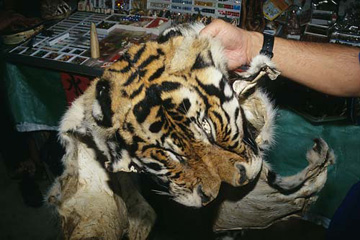Highlighting the poaching crisis facing tigers, a new report by the wildlife trade organization, TRAFFIC, found that from 2000-2010 authorities have confiscated the parts of 1,069 tiger individuals, many of them dead. The tigers, or their body parts, were confiscated from 11 of the species’ 13 range countries, according to the report entitled Reduced to Skin and Bones. Yet the number only hints at the total number of tigers (Panthera tigris) vanishing in the wild due to the illegal trade in tiger parts for traditional Asian medicine and decorative items, such as skins.
“With parts of potentially more than 100 wild Tigers actually seized each year, one can only speculate what the true numbers of animals are being plundered,” said Pauline Verheij, author of the report and joint TRAFFIC and WWF Tiger Trade Program Manager, in a press release.
China, India, and Nepal saw the most confiscations of illegal tiger parts over the last decade, according to the report. India came in as number one, but the authors say that is not surprising given that India’s has the world’s highest population of tiger. Confiscations increased in Nepal, Indonesia, Vietnam, and Thailand.
 Confiscated tiger skin. Photo copyright by TRAFFIC. |
“To save tigers in the wild, concerted action is needed to reduce the demand for tiger parts altogether in key countries in Asia,” said Steven Broad, Executive Director of TRAFFIC.
A tiger summit is meeting in St. Petersburg, Russia at the end of the month with a goal of doubling the population of tigers in 12 years.
“The forthcoming summit is a vital one for the future of wild Tigers, their very future hangs in the balance,” says Broad.
Millions of dollars have already been poured into the effort to save the tiger from extinction, yet the world’s biggest cat continues to see decline in its wild population due to habitat loss, prey decreases, conflict with humans, and, of course, illegal poaching. Currently it is estimated that some 3,500 tigers survive in the wild, down from 100,000 a century ago.
The great cat is listed as Endangered by the IUCN Red List, although two of its subspecies, the Sumatran tiger (Panthera tigris sumatrae) and the South China tiger (Panthera tigris amoyensis) are considered Critically Endangered.
Three tiger species went extinct over the last century, the Bali tiger (Panthera tigris balica), the Javan tiger (Panthera tigris sondaica), and the Caspian tiger (Panthera tigris virgata), though recent research indicates that the Caspian tiger may not have been a distinct subspecies at all, but was quite close to the Siberian (Panthera tigris altaica).
Related articles
Video: camera trap catches bulldozer clearing Sumatran tiger habitat for palm oil
(10/14/2010) Seven days after footage of a Sumatran tiger (Panthera tigris sumatrae) was taken by a heat-trigger video camera trap, the camera captured a bulldozer clearing the Critically Endangered animal’s habitat. Taken by the World Wildlife Fund—Indonesia (WWF), the video provides clear evidence of forest destruction for oil palm plantations in Bukit Batabuh Protected Forest, a protected area since 1994.
Interpol pounces on tiger traffickers
(10/11/2010) INTERPOL, the world’s largest international police organization, is stepping up the fight to end the illegal tiger trade.
Hope remains for India’s wild tigers, says noted tiger expert

(09/30/2010) As 2010 marks ‘The Year of the Tiger’ in many Asian cultures, there has been global interest in the long-term viability of tiger populations in the wilds of Asia. Due to increasing pressures on remaining tiger habitats and a surge in demand for tiger parts from traditional medicine trades, many conservation experts consider the current outlook for wild tiger populations bleak. Dr Ullas Karanth of the Wildlife Conservation Society (WCS) India does not share this view. He believes that a collaboration of global and local interests can secure a future for tigers in the wild.